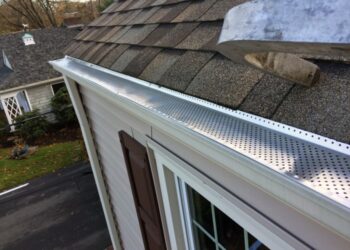Metal experts roofing and siding offer a modern solution to traditional construction, combining durability and aesthetics in a way that is unmatched. As we delve into the realm of metal roofing and siding, a world of innovation and practicality unfolds before us.
Let’s embark on this journey to discover the wonders of metal experts in the realm of construction.
In the following paragraphs, we will explore the different types of metal roofing and siding, the installation process, maintenance tips, cost analysis, and more, providing a comprehensive guide for those interested in this cutting-edge technology.
Introduction to Metal Experts Roofing and Siding
Metal roofing and siding are construction materials made from metal sheets or tiles, providing durable and long-lasting protection for residential and commercial buildings. These materials are known for their strength, resistance to extreme weather conditions, and low maintenance requirements.
Benefits of Using Metal Materials
Metal roofing and siding offer numerous advantages over traditional materials like asphalt shingles or wood siding. Some key benefits include:
- Longevity: Metal roofs and siding have a longer lifespan compared to other materials, lasting 50 years or more with proper maintenance.
- Durability: Metal is resistant to fire, rot, insects, and mildew, ensuring the structural integrity of the building.
- Energy Efficiency: Metal reflects solar heat, reducing cooling costs in the summer and improving energy efficiency.
- Environmentally Friendly: Metal roofing and siding are recyclable, making them a sustainable choice for eco-conscious consumers.
Importance of Hiring Professionals like Metal Experts
When it comes to installing or repairing metal roofing and siding, it is crucial to hire experienced professionals like Metal Experts. Some reasons include:
- Precision Installation: Professionals have the expertise and tools to ensure proper installation, preventing leaks and other issues.
- Compliance with Building Codes: Professional contractors are familiar with local building codes and regulations, ensuring that the project meets all necessary requirements.
- Warranty Coverage: Hiring professionals often comes with warranty coverage on labor and materials, providing peace of mind for the property owner.
- Safety Measures: Roofing and siding projects can be dangerous, so professionals have the training and equipment to maintain safety on the job site.
Types of Metal Roofing and Siding
Metal roofing and siding offer a durable and aesthetically pleasing option for residential and commercial buildings. There are different types of metal roofing and siding available, each with its own unique characteristics and benefits.
Metal Roofing:
- Standing Seam: Standing seam metal roofs have vertical panels with interlocking seams that provide a sleek and modern look. They are known for their durability and resistance to leaks.
- Metal Shingles: Metal shingles mimic the appearance of traditional roofing materials like wood or slate. They offer a variety of colors and styles while providing the durability and longevity of metal.
- Corrugated Metal: Corrugated metal roofing consists of panels with ridges and grooves that provide strength and structural integrity. They are commonly used in industrial and agricultural buildings.
Metal Siding:
- Steel: Steel siding is a popular choice for its strength and durability. It can withstand harsh weather conditions and is resistant to fire, insects, and rot.
- Aluminum: Aluminum siding is lightweight, rust-resistant, and easy to maintain. It is available in a variety of finishes and colors to complement any architectural style.
- Zinc: Zinc siding offers a unique aesthetic appeal with a natural patina that develops over time. It is a sustainable and eco-friendly option that requires minimal maintenance.
Metal roofing and siding options vary in terms of durability, maintenance requirements, and aesthetics. Consider the specific needs of your building and the desired look when choosing the right type of metal roofing and siding for your project.
Installation Process
Metal roofing and siding are popular choices for their durability and aesthetic appeal. The installation process for both involves specific steps and the use of appropriate tools and equipment.
Installing Metal Roofing
Metal roofing installation typically involves the following steps:
- Prepare the roof deck by ensuring it is clean, dry, and free of any debris.
- Install underlayment to provide an extra layer of protection against water infiltration.
- Measure and cut the metal panels to fit the roof dimensions, ensuring proper overlap for waterproofing.
- Secure the metal panels to the roof deck using screws or clips, following the manufacturer’s guidelines.
- Finish the edges with flashing to prevent water seepage and ensure a clean, professional look.
Installing Metal Siding
The process of installing metal siding on a building involves the following steps:
- Prepare the walls by ensuring they are clean, dry, and free of any obstructions.
- Measure and cut the metal siding panels to fit the wall dimensions, allowing for proper alignment and overlap.
- Attach the siding panels to the wall using nails or screws, following the manufacturer’s instructions for spacing and fastening.
- Finish the corners and edges with corner caps and trim pieces to provide a clean, finished appearance.
- Ensure proper sealing around windows, doors, and other openings to prevent water infiltration.
Tools and Equipment
The installation of metal roofing and siding requires the use of specific tools and equipment, including:
- Power drill or screw gun for fastening metal panels
- Tin snips or metal cutting shears for cutting metal panels to size
- Measuring tape and chalk line for accurate measurements and layout
- Safety gear such as gloves, safety glasses, and a harness for working at heights
- Roofing nails, screws, and other fasteners specified by the manufacturer
Maintenance and Care
Metal roofing and siding are durable options for your home, but they still require regular maintenance to ensure longevity and optimal performance.
Maintenance Tasks for Metal Roofing
- Regularly inspect the roof for any signs of damage such as dents, scratches, or loose panels.
- Clean debris such as leaves, branches, and dirt from the roof to prevent water buildup and potential corrosion.
- Trim overhanging branches to prevent damage from falling limbs and debris.
- Check and clean the gutters to ensure proper drainage and prevent water from backing up under the roof panels.
- Apply a protective coating or sealant to the roof as recommended by the manufacturer to prolong its lifespan.
Tips for Prolonging the Lifespan of Metal Siding
- Regularly wash the siding with a mild detergent and water to remove dirt, dust, and grime that can cause discoloration.
- Inspect the siding for any signs of rust or corrosion and address them promptly to prevent further damage.
- Repaint or touch up the siding as needed to maintain its protective coating and prevent exposure to the elements.
- Trim vegetation around the siding to prevent moisture buildup and potential damage.
- Avoid using harsh chemicals or abrasive materials when cleaning the siding to prevent scratching or damaging the surface.
Common Issues with Metal Roofing and Siding
- Leaks: Inspect the roof and siding regularly for leaks and address any issues with proper sealing or repairs.
- Dents or Scratches: Touch up or repair any dents or scratches to prevent corrosion and maintain the integrity of the metal.
- Rust or Corrosion: Treat any signs of rust or corrosion promptly to prevent further damage and extend the lifespan of the roof and siding.
- Noise: Metal roofing can be noisy during heavy rain or hail, consider adding insulation or soundproofing to reduce noise levels.
- Discoloration: Regular cleaning and maintenance can help prevent discoloration of metal roofing and siding due to dirt, pollution, or weather exposure.
Cost Analysis
Metal roofing installation costs can vary depending on several factors. Factors that contribute to the overall cost include the type of metal used, the size of the roof, the complexity of the design, and the labor costs. Additionally, factors such as insulation, underlayment, and accessories can also impact the total cost of installation.
Comparison with Traditional Materials
When comparing the initial investment of metal roofing and siding with traditional materials like asphalt shingles and vinyl siding, metal may have a higher upfront cost. However, it is essential to consider the long-term savings that metal roofing and siding can provide.
Metal is known for its durability and longevity, requiring less maintenance and repairs over time compared to traditional materials. This can result in cost savings in the long run, making metal a cost-effective option despite the higher initial investment.
Epilogue
As we conclude our exploration of metal experts roofing and siding, one thing becomes clear – the future of construction lies in the hands of these professionals. With their expertise and dedication, they pave the way for a new era of sustainable, durable, and visually appealing buildings.
Embrace the possibilities that metal roofing and siding offer, and witness the transformation of your construction projects.
User Queries
What are the benefits of using metal materials for roofing and siding?
Metal materials offer superior durability, longevity, and resistance to elements like fire and pests compared to traditional materials.
What are the different types of metal roofing available?
Some options include standing seam, metal shingles, and corrugated metal, each with its unique features and advantages.
How can I prolong the lifespan of metal siding?
Regular cleaning, inspection for damage, and timely repairs can help extend the lifespan of metal siding.
What is the cost comparison between metal roofing and traditional materials?
While metal roofing may have a higher initial cost, its long-term savings in maintenance and energy efficiency often justify the upfront investment.







